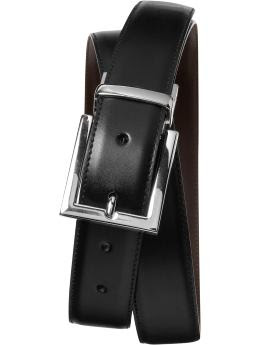I enjoy the beltless look with a suit, and have gotten some questions about it. Some like the look and wonder how to effectively go beltless. Others have been quite taken aback, never imagining that such a thing as wearing a suit with no belt could or should happen. They feel an ensemble is incomplete without a belt. Wherever you find yourself on the belt debate, here are some arguments for wearing a belt, and how to choose a good one. My next post will discuss the virtues of no belt.
 Why wear a belt
Why wear a belt
The most basic question is do your trousers stay up and in the position you want them? If the answer is no, then a belt is in order. Aside from if your trousers need help staying put, there are some other pro-belt arguments to consider. Because a belt forms a horizontal line around your midsection, it serves to break up the lines and colors of your suit. This may be more subtle with dark suits (think black on black) and more pronounced with lighter suits (think of a light gray suit with a dark brown or black belt). Some, like very tall people, might see this as a positive, as it takes away from their height a bit by breaking up the lines. A belt can also be helpful for those who like to wear their pants above the hips. Depending on your height and proportions, keeping your pants higher on your waist could help even out a long torso and shorter legs by making your legs appear longer than they are.
If you're wearing a sportcoat or something a bit more casual than a suit, a belt is a good accessory and can add nice accents of color, and is possible more appropriate than no belt, since your jacket will be a different color than your trousers anyway.
Choosing the right beltThe first rule is that the belt should match your shoes. Black with black. Dark brown with dark brown. Tan with tan. With browns, it can be tricky to find the right shade. The colors don't have to match exactly, but should be pretty close, I'd say close enough that it's not blatantly obvious that your belt is a different shade than your shoes.

The textures of your belt and shoes do not need to match. With most leathers this probably isn't a concern. If you're talking about a more distinctive texture, such as alligator skin, having a matching belt and shoes can look tacky, like having a matching tie and pocket square. You don't buy these things in sets. The shades should match, but not the texture. Nicer belts that are intended to be worn with nicer clothes are more finished looking. The leather is shinier and it has clean, subtle stitching. Casual belts that look frayed and unfinished should be worn with jeans, not suits.
The belt shouldn't be too wide or too narrow. That's a bit vague, but generally speaking, the belt should fit the loops it'll be going through. I wouldn't try to stuff a wider belt that's better suited for jeans through trousers, just as a sleeker belt with jeans would look out of place.
The belt buckle should be sleek, subtle, and preferably silver colored. Gold colored is okay if you're heavily accessorized with gold elsewhere. It should also be classy. No logos or crazy designs. It should have clean lines and should be squared, rectangular, or either of those with slightly rounded corners.
















 a coat, or better yet, have it custom made for you. Make sure the coat has good shape. Just because it's long doesn't mean it should be boxy, roomy, or otherwise ill-fitting.
a coat, or better yet, have it custom made for you. Make sure the coat has good shape. Just because it's long doesn't mean it should be boxy, roomy, or otherwise ill-fitting.




































